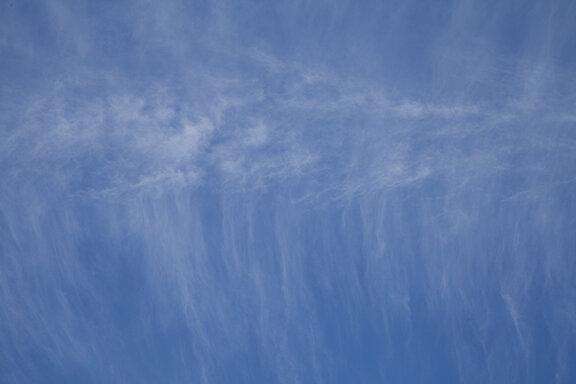How do we determine cloud types? We look at them to see their shape and estimate their altitude. Most often the type of cloud is easy to identify - is it puffy, layered, or wispy? About how high is it? However, in some cases identification is not so easy. The photos below provide examples of clouds that look very similar. The clouds are located either at the top of the middle cloud level or the bottom of the high cloud level. They could be middle or high clouds. It becomes an educated guess. The same problem occurs when clouds are near the top of the low cloud level or the bottom of the middle cloud level. Are they middle or low clouds?
It is helpful if an airport is near by. Cloud heights are measured at commercial airports and made available on coded weather observations. If you have an airport near you that measures cloud height you might be able to determine if the cloud base is in the low or middle level. If the height is lower than 6,000 feet it is a low cloud. If higher, it is a middle or high cloud.
But here is the problem. Cloud heights are only measured to 12,000 feet and middle clouds extend up to 18,000 feet. So above 12,000 feet you are on your own in estimated whether clouds are in the middle or high level. It is not an exact science. That’s where cloud appearance and experience comes in handy - along with a good cloud chart. Looking at the shape, size and texture of a cloud is very helpful for determining its height and type. The size of individual cloud elements helps determine the height. Low cumulus are larger than middle level cumulus which are larger than cirrus level cumulus. The size of cloud elements becomes a key in estimating height.
Clouds are placed in families based upon their height; high, middle, or low. There is a special cloud type, known as accessory clouds, but we won’t get into that now. Within cloud families are basic types; cirrus, cumulus, and stratus. Cirrus are high and wispy, cumulus are puffy, and stratus are layered. That part is easy.
Difficulties arise when clouds are near the artificial dividing heights between low, middle, and high clouds. The photos below illustrate the problem. Are the clouds middle or high clouds? The shape and texture tell us the type and what processes are creating the clouds. We make the best estimate we can.
So, looking at the photos below, are the clouds middle level or high? To put it another way are they in the cirrus (cirrocumulus) category or the middle cloud (altocumulus) category? I made some educated guesses based on the individual element sizes. I know for sure they are not low clouds because they look far away and the cloud elements are smaller than low clouds. Whether they are middle or high is subject to opinion. There are both stratus and cumulus types in a few of the photos. The other photos have only cumulus types.
This description is under construction.































































































